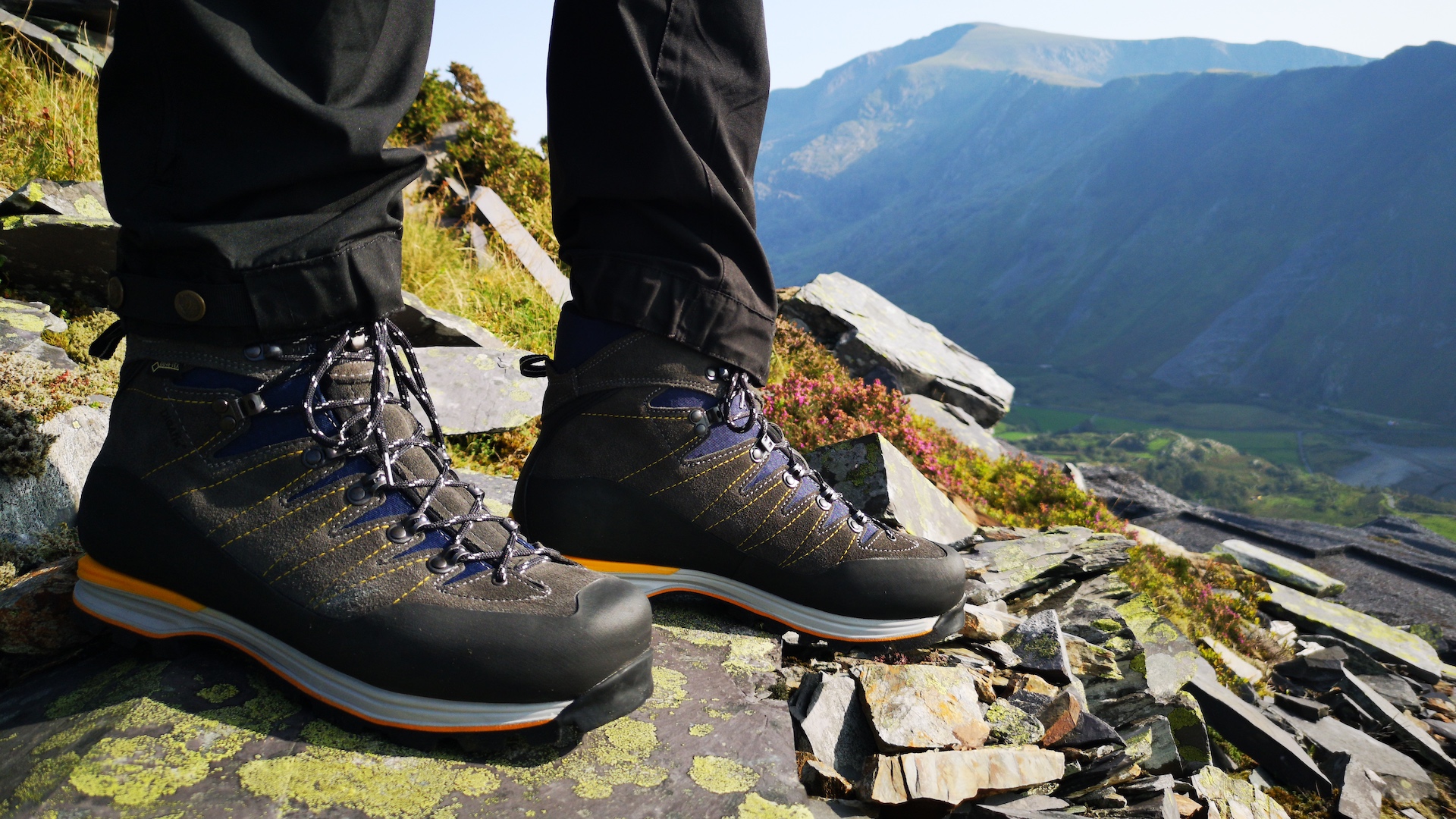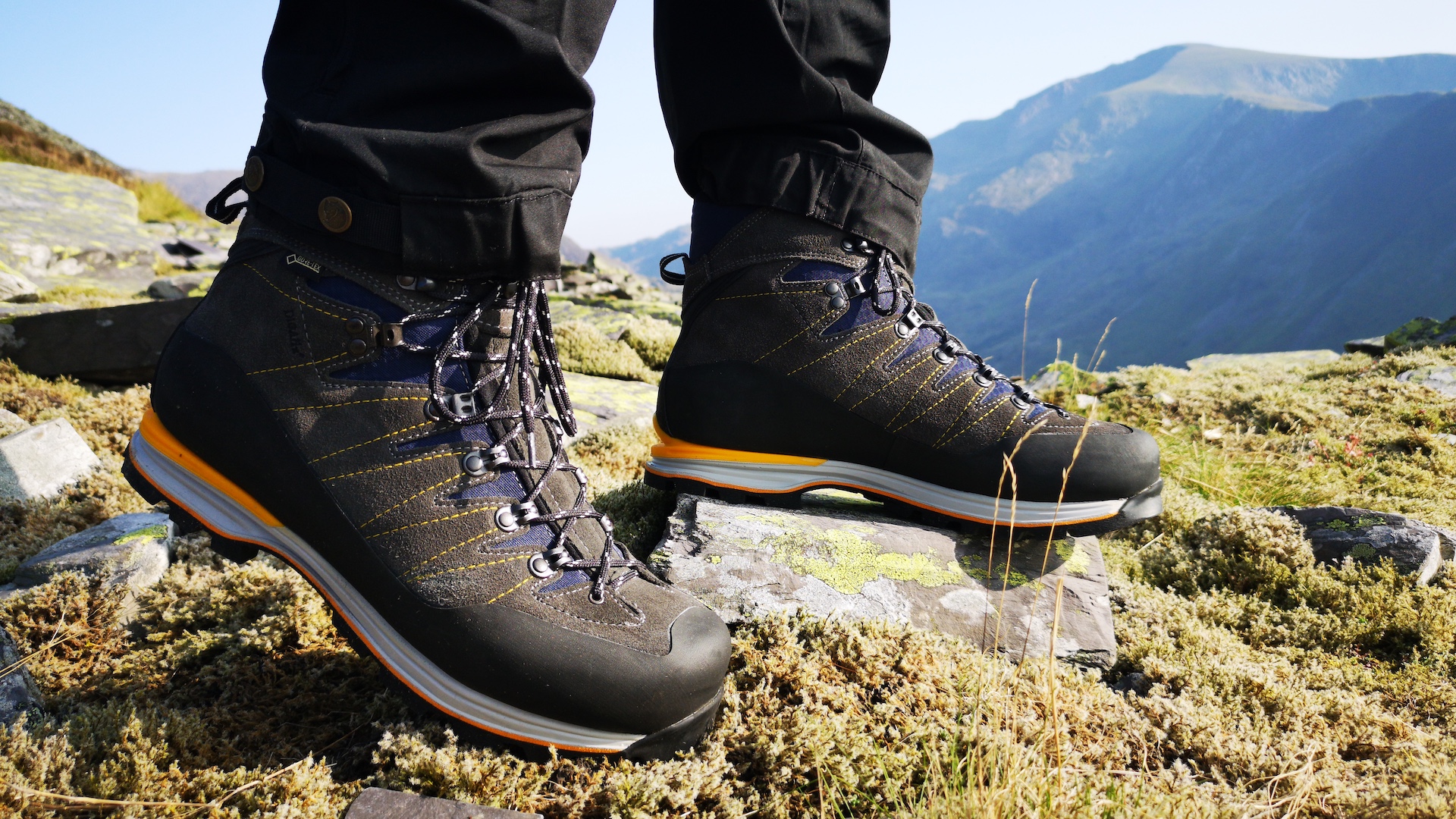Advnture Verdict
If you’re after a great all-season, all-rounder that prioritises walking comfort over performance on steeper ground, but still has the ability to fit a crampon for the odd icy section on a cold-weather mountain or hill day, the Air Revolution 4.1 is a superb choice.
Pros
- +
Well-cushioned
- +
Breathable
- +
Comfortable
- +
Lightweight
Cons
- -
Not the most protective or supportive because of the lower ankle cuff
- -
Not the stiffest for technical terrain
You can trust Advnture
Meindl Air Revolution 4.1: first impressions
Is the Meindl Air Revolution 4.1 a “one boot to rule them all”? Because that’s what you want if you prefer the sturdy dependability of a leather boot to the flexibility of a lightweight fabric boot, even in summer – a boot that you can wear year-round, even when winter rolls in. This means you don’t have to worry about switching footwear from season to season. It also guarantees a better level of protection and support throughout the year – ideal for those with long-standing ankle issues or who like to tackle rough and rugged terrain.
Most examples of year-round, four-season boots look fairly traditional, being made from full-grain leather – Altberg’s Mallerstang and Scarpa’s SL Active are two classic examples (and actually, both are well worth a look if you’re after a classic four-season B1 boot). But they do tend to be a little hot and heavy in milder weather. The Meindl Air Rev 4.1 is an altogether more modern alternative. Rather than being full-grain leather, the uppers are made from suede leather and mesh, with a Gore-Tex lining. This saves considerable weight while also making for a more breathable construction.
In fact, Meindl have put a lot of thought into keeping your feet cool in these boots. They employ the brand’s Air Revolution technology, with a clever dual-layer tongue that incorporates ventilation channels to circulate cool air into the boot and pump out warm, moist air. The idea is to keep your feet drier and more comfortable across a wider temperature range.
But how did they fare when we put them through their paces for our best winter hiking boots buying guide? Read on…
• RRP: £282.50 (UK) / €330 (EU)
• Sizes available: (EU) 38-47, (UK) 5-12
• Materials: Suede and mesh uppers, Gore-Tex membrane lining, Vibram Alpin Rigid outsole
• Weight (per boot): 700g / 1lb 8.7oz
• Colors: Grey & Orange / Ochre & Petrol
• Compatibility: Four season, B1-B2
Meindl Air Revolution 4.1: on the trails

We tested these boots on a range of classic mountain trails in Snowdonia, North Wales – a region known for its variable conditions and mixed of terrain underfoot, particularly in winter. Overall, we were very impressed with their all-day comfort and general hiking performance. This is a boot built for big miles – ideal for hillbagging, whether you’re ticking off Scottish Munros, Welsh 3000s or Lakeland Wainwrights. They also perform well for high-level backpacking routes, giving sufficient support and alleviating foot fatigue if trekking with a big pack.
Having said that, we wouldn’t try and push these boots beyond their limits, particularly in winter conditions. They’re not quite stiff enough to feel stable on steep, technical terrain, and although it is possible to fit a crampon to them, they’re still primarily designed as a walking boot. If you want a dedicated winter mountain boot, there are undoubtedly better choices. But as an all-season, all-rounder, with only occasional crampon use, they work well.
Here’s how they performed in each of the key metrics by which we gauge a hiking boot’s performance (find more on these in how to choose a pair of hiking boots):
All the latest inspiration, tips and guides to help you plan your next Advnture!
Comfort
The Air Revolutions undoubtedly get top marks in this regard. They were the most comfortable boots in our test selection, and in fact they’re pretty much as comfortable as most lightweight fabric hikers. That’s impressive for a boot with crampon compatibility.
It’s all down to the construction of the uppers, which are well-padded in all the right places, yet incorporate Meindl’s clever dual-layer tongue, which acts as a tongue to pump out warm, moist air and circulate cooler air into the boot. It really seems to work, keeping feet comfortable throughout the day.
Of course, in full winter conditions, they’re not the warmest, but this shortcoming can be mitigated with thick, winter-weight mountaineering socks.
The low weight ensures they don’t feel too clumpy, and unlike traditional B1 or B2 boots, they don’t feel like you’ve strapped anvils to your feet. In fact, given their deluxe construction, their lightweight feel is quite remarkable.
Fit
Like a lot of German boot brands, Meindl footwear is known for being slightly wider and more accommodating than most. There are exceptions to this in the Meindl range, so regard this advice as a rule of thumb rather than gospel, but to us the Air Rev 4.1 seemed to conform to the rest of our experience with their boots. They’re fairly broad fitting throughout, with a wide toe box – ideal if you have regular or slightly wide feet, less so if you have narrow feet. (See also: How should hiking boots fit?)
Performance
The brand’s own classification system puts the Air Rev 4.1 in their Grade B/C category, signifying a boot designed for multi-day trips, demanding trekking, extended mountain hikes, poor paths, scree and fixed rope routes. As such, the Air Rev 4.1 sort of sits midway between a robust hiking boot and a “proper” mountain boot.
By UK standards and terminology, it is definitely a hillwalking-focused design. However, it still boasts many of the features associated with a true mountaineering boot. This includes lacing that extends almost to the toe, a wraparound rand, a Vibram Alpin Rigid outsole and a midsole with a PU wedge and integrated heel welt.
The boot isn’t quite as stiff as those with a full-length or three-quarter length shank but is still suitable for occasional crampon use. Thanks to that heel welt it is even compatible with a C2 crampon. We’d recommend these if you’re a year-round UK hillwalker who likes to take the odd summer Alpine trip. They can certainly tackle icy or snowy sections of an Alpine trek, and can also cope with frozen fells or the less demanding winter Munros. Basically, if you carry 10-point crampons and a straight piolet-style ice axe, the Air Rev 4.1 will be the boot for you. For anything more technical, you might want a slightly more capable boot (perhaps the Meindl Himalaya or Jorasse, for example).

Protection
Given their lighter materials and construction, they don’t offer quite the same level of protection as a full-leather boot or a technical synthetic boot (eg, the Zamberlan Baltoro or the La Sportiva Trango Tower). For their low weight, however, these boots are impressively protective and durable, while also being breathable and extremely well-cushioned.
Durability
This boot felt well-made and showed little signs of wear after a test period of a few months. The wraparound rand tends to ward off debris and minimize scuffs or tears to the suede uppers, though above the rand the zigzag stitching is perhaps a slight cause for concern – in our experience, stitching is usually a weak point in boots. (See also: How to clean hiking boots in five easy steps.)
Anecdotally, we’ve heard stories of premature failure with a few models of Meindl work and leisure boots recently, but the Air Revolution 4.1 doesn’t seem to be one of the models affected.
An outdoors writer and editor, Matt Jones has been testing kit in the field for nearly a decade. Having worked for both the Ramblers and the Scouts, he knows one or two things about walking and camping, and loves all things adventure, particularly long-distance backpacking, wild camping and climbing mountains – especially in Wales. He’s based in Snowdonia and last year thru-hiked the Cambrian Way, which runs for 298 miles from Cardiff to Conwy, with a total ascent of 73,700 feet – that’s nearly 2½ times the height of Everest. Follow Matt on Instagram and Twitter.


